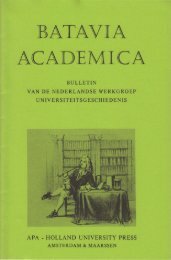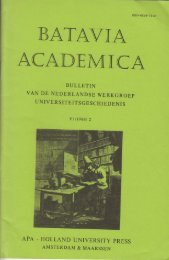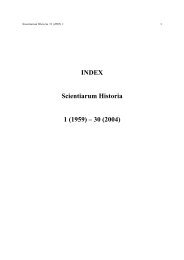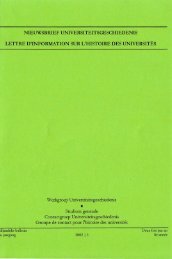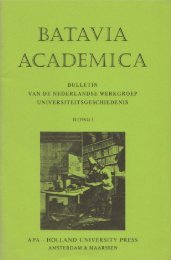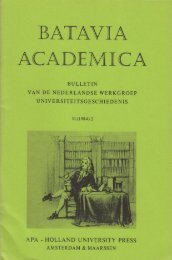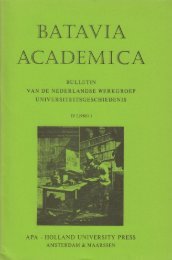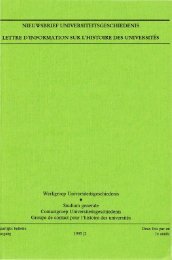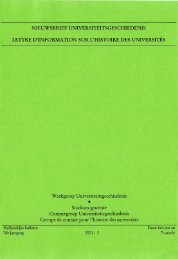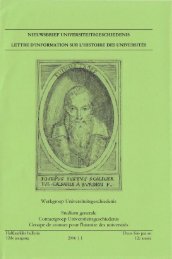EXPORTING SCIENTIFIC INSTRUMENTS AROUND 1700 - Gewina
EXPORTING SCIENTIFIC INSTRUMENTS AROUND 1700 - Gewina
EXPORTING SCIENTIFIC INSTRUMENTS AROUND 1700 - Gewina
You also want an ePaper? Increase the reach of your titles
YUMPU automatically turns print PDFs into web optimized ePapers that Google loves.
100 Peter de Clercq<br />
Percussion apparatus<br />
Below his trade catalogue (see appendix) Musschenbroek wrote: "Mr. de Voider<br />
has an instrument to show the laws of movement, which is very handsome, costs<br />
about 60 guilders."^* The wording suggests that professor Burchardus de Voider<br />
had built this percussion apparatus himself, or had bought it elsewhere, so that<br />
in this case Musschenbroek drew on the university collection to enlarge his<br />
repertoire. Dorstenius ordered one straight away, but Musschenbroek did not<br />
sell this kind of apparatus off the shelf,'" and it was not until May 1695 that<br />
"I'instrument pour le choc du corps" was dispatched to Marburg. Musschenbroek,<br />
who sent a description with drawing (Fig. 7), specified that it was to be<br />
hung on the wall and was fitted with graduated brass arcs, along which the effect<br />
of collision of the two suspended ivory balls could be read off. It cost Hfl 30,<br />
only half the original tentative quotation. Had Musschenbroek overestimated the<br />
job? His accompanying letter suggests a better explanation. He had sent the<br />
instrument with two hard-wooden balls, costing one guilder each. The much<br />
harder ivory, as given in the instruction, would be better, he wrote, but these<br />
were easily twenty guilders, and Musschenbroek probably knew that Dorstenius<br />
had to be economical. But he added with proper business acumen: "if Monsieur<br />
wishes the ivory balls I shall gladly have them made."'"<br />
Hydrostatics<br />
Of the six types of hydrostatic apparatus bought by Dorstenius in 1694 and 1695,<br />
only two had been mentioned in the catalogue. One was a brass container to<br />
determine the weight of half a cubic foot of water, based on Archimedes'<br />
principle; the other is di.scussed below. Novelties were a syphon fountain (Fig.<br />
8); two glass hydrometers graduated by small globules of glass projecting from<br />
27.<br />
For De Voldcr's own percussion apparatus see De Clercq (n. 8), Leiden Cabinet of Physics, p.<br />
Letter 20 September 1694: "L'instrument pour les loix de mouvement n'est pas encore fait et<br />
depuis que je n'avoit point de temps en une mois je n'o,soit pas attendre si longtemps pour I'hiver<br />
et je le fera si tost qu il me sera possible."<br />
Letter 11 May 1695: "J'ay seulement pendu 2 boules du bois dur. L'yvoire est mieux parce<br />
quils sont plus dur, mais ils sont fort cher, ils voudrent bien 20 florin pour les deux, et vous pouvez<br />
loujours lais.ser faire ... Si Mons' desire les boules d'yvoire je laisseray bien faire." The invoice<br />
breaks the apparatus down as "L'instrument pour le ch(Xj du corps" (Hfi 30) and "les 2 boules" (Hfl<br />
2). Valentini, in his compiled list of Musschenbroek's instruments (see section 3), renders this as<br />
'Hugenii Chronoscopium" (Hfl 30) and "Die zwey helffenbeinerne Kugeln darzu" (Hfi 2). The fact<br />
that he gave the price of the wooden balls but specifies the balls as made of ivory (German: elfenbein)<br />
suggests that he saw Musschenbroek's instruction for use and the invoice, but not the<br />
accompanying letter. ITie designation of the instrument as Hugenii Chronoscopium brings to mind<br />
Christiaan Iluygens' contribution to the formulation of the laws of collision.



